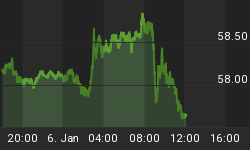On August 4th both the Industrials and the Transports closed below their previous secondary low points. This is the first time since the March 2009 low that this has occurred and in doing so the primary trend turned bearish in accordance with Dow theory. Once a primary trend change is established, that primary trend is considered to be intact until it is authoritatively reversed. In this case, such a reversal requires a move above the previous secondary high point, which has not occurred. Initially, it appeared that the August low had marked a secondary low point. However, with the violation of the August lows, we are seeing an additional probe into the secondary low points as the averages fish for these lows. The current Dow theory chart can be found below.

As I have said here since the primary trend change occurred in August, this development cannot be ignored. But, at the same time, there are also other technical factors that are not consistent with the Dow theory that can't be ignored either. It is for this reason that we continue to approach this Dow theory trend change with caution. Reason being, history shows us that not all Dow theory trend changes are created equally. For example, as the secular bull and bear market periods grew, we began to see Dow theory trend changes occur within the context of the longer-term trend. This was first seen in 1946. This also occurred in 1948, 1951, 1953, 1956, 1960, 1962 and 1965. Sure, these were important tops in the market, but none of them marked THE top of the secular bull market. The leading Dow theorist of that time was E. George Schaefer and he recognized that the secular bull market had stretched in duration. As a result, Mr. Schaefer explained that he used "other technical studies," outside of traditional Dow theory, to filter these Dow theory trend changes.
I want to add that during the secular bull market period that ran between 1974 and 2007, there were also a number of traditional Dow theory trend changes. Such trend changes were seen in 1977, 1981, 1984, 1987, 1990, 1998 and as it turns out, even the trend change that occurred at the 2000 top proved to have occurred within the context of the longer-term secular bull market, which appears to have finally peaked in 2007. Again, these were all important tops. But, none of them were THE top. Thus, history clearly shows that Dow theory trend changes are not always ominous nor do they always set the longer-term trend for the market.
With this all said, my long-term view has NOT changed. I continue to believe that the rally out of the March 2009 low is a bear market rally that will ultimately separate Phase I from Phase II of a much longer-term secular bear market. However, based on other technical studies, which are discussed in detail in my monthly research letters, this bearish Dow theory trend change is questionable. In fact, just as Mr. Schaefer used other "technical studies" to filter the Dow theory trend changes, there is data that suggests this may well prove to be a very good buying opportunity and that the rally out of the March 2009 low has not runs its course. If certain structural events were to occur before the next secondary low point is seen, then such developments will begin to trump these "other technical studies." Until such time, the overall technical data suggests that a larger bear trap is likely to be set before the real decline into the Phase II low takes root.
I have begun doing free market commentary that is available at www.cyclesman.net The specifics on Dow theory, my statistics, model expectations, and timing are available through a subscription to Cycles News & Views and the short-term updates. I have gone back to the inception of the Dow Jones Industrial Average in 1896 and identified the common traits associated with all major market tops. Thus, I know with a high degree of probability what this bear market rally top will look like and how to identify it. These details are covered in the monthly research letters as it unfolds. I also provide important turn point analysis using the unique Cycle Turn Indicator on the stock market, the dollar, bonds, gold, silver, oil, gasoline, the XAU and more. A subscription includes access to the monthly issues of Cycles News & Views covering the Dow theory, and very detailed statistical based analysis plus updates 3 times a week.
















